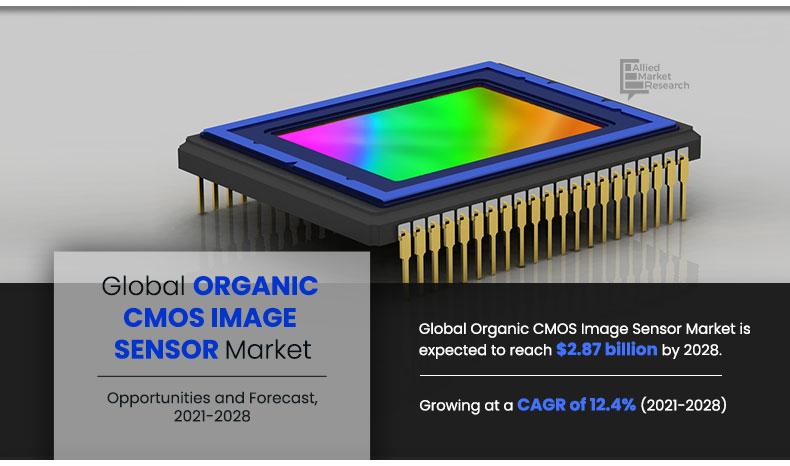Organic CMOS Image Sensor Market Research, 2028
The global organic CMOS image sensor market size was valued at $1.19 billion in 2020, and is projected to reach $2.87 billion by 2028, registering a CAGR of 12.4% from 2021 to 2028. An organic CMOS image sensor is a new technology in CMOS image sensors, which consists of features such as wide dynamic range with high sensitivity; hence, it is possible to capture a clear image with vivid colors and rich textures even in a low-light environment. An organic CMOS image sensor uses an organic photoelectric conversion layer with high photoelectric conversion property, which provides better performance than conventional image sensors by increasing the number of pixels and providing high-resolution images.
The global organic CMOS image sensor market is anticipated to witness significant growth during the forecast period. Factors, such as high image quality and better color contrast, provided by organic CMOS image sensors, drive the global market. In addition, the introduction of technologies, such as global shutter technology, is expected to fuel the adoption of organic CMOS image sensors. However, organic sensor drains the battery quickly as compared to the available image sensors, which may hinder the growth of the organic CMOS image sensor market. Conversely, high reliability for broader applications and faster & cheaper processing methods are anticipated to drive the growth of the market in the future.
Segment Overview
The global organic CMOS image sensor market is segmented based on image processing, array type, application, industry vertical, and region. By image processing, the market is bifurcated into 2D sensors and 3D sensors.
By array type, the market is classified into linear image sensors and area image sensors. Based on application, the market is divided into 3D imaging, video, machine vision, biometrics, and others
By Type
3D Sensors segment is projected as one of the most lucrative segments.
Depending on the industry vertical, the market is segregated into consumer electronics, automotive, medical & life sciences, security & surveillance, robotics, and others.
By Ink Type
Consumer Electronics segment is expected to secure leading position during forecast period.
Region-wise, the organic CMOS image sensor industry trends are analyzed across North America (the U.S., Canada, and Mexico), Europe (UK, Germany, France, and Rest of Europe), Asia-Pacific (China, Japan, India, South Korea, and Rest of Asia-Pacific), and LAMEA (Latin America, the Middle East, and Africa). Asia-Pacific is dominating the organic CMOS image sensor market, owing to rising demand for consumer electronics products and rapid development in the medical & life sciences sector in this region. In addition, Asia-Pacific is projected to register a significant growth rate during the forecast period. Furthermore, North America holds the second position, followed by Europe.
By Region
Asia-Pacific region would exhibit the highest CAGR of 16.1% during 2021-2028
Top Impacting Factors
The prominent factors that impact the organic CMOS image sensor market growth are better performance in low light & temperature variations and the introduction of 8k resolution technology. However, excessive heat generation in organic sensor technology restricts the market growth. On the contrary, an increase in penetration of image sensors in automobiles and high reliability for broader applications are expected to create lucrative opportunities for the market growth. These elements are expected to affect the development of the global organic CMOS image sensor market outlook during the forecast period.
Competition Analysis
Competitive analysis and profiles of the major organic CMOS image sensor market players, such as ams AG, Canon Inc., Fujifilm Holdings Corporation, NikkoIA SAS, OmniVision Technologies, Inc., Panasonic Corporation, Samsung Electronics Co., Ltd., Siemens AG, Sony Corporation, and Xenics NV, are considered in the report.
Key Benefits For Stakeholders
- This study comprises an analytical depiction of the global organic CMOS image sensor market trends along with the future estimations to depict the imminent investment pockets.
- The overall organic CMOS image sensor market analysis is determined to understand the profitable trends to gain a stronger foothold.
- The report presents information related to key drivers, restraints, and opportunities with a detailed impact analysis.
- The current organic CMOS image sensor market forecast is quantitatively analyzed from 2020 to 2028 to benchmark the financial competency.
- Porter’s five forces analysis illustrates the potency of the buyers and the organic CMOS image sensor market share of key vendors.
- The report includes the market trends and the market share of key vendors.
Organic CMOS Image Sensor Market Report Highlights
| Aspects | Details |
| By Image Processing |
|
| By Array Type |
|
| By Application |
|
| By Industry Vertical |
|
| By Region |
|
| Key Market Players | Xenics nv, NikkolA SAS, Siemens AG, ams AG, Sony Corporation, Canon Inc., Panasonic Corporation, Fujifilm Holdings Corporation, OmniVision Technologies, Inc., Samsung Electronics Co. Ltd. |
Analyst Review
An organic CMOS image sensor technology uses organic photoelectric conversion layer with high absorption coefficient providing wider incident light, which prevents highlight clipping in brightness and captures images with rich textures even in dark environment. It offers benefits over traditional image sensors such as higher dynamic range and higher sensitivity.
The global organic CMOS image sensor market is anticipated to witness significant growth during the forecast period. Factors, such as high image quality and better color contrast, provided by organic CMOS image sensor drive the global market. In addition, introduction of technologies, such as global shutter technology, is expected to fuel the adoption of organic CMOS image sensors. However, organic sensor drains battery quickly as compared to the available image sensors, which may hinder the growth of the organic CMOS image sensor market. Conversely, high reliability for broader applications and faster & cheaper processing methods are anticipated to drive the growth of the market in future.
The key players of the market focus on introducing technologically advanced products to remain competitive in the market. Product launch, and acquisition are expected to be the prominent strategies adopted by the market players. North America accounted for a major share of the market in 2020, owing to the presence of major players in the region; however, Asia-Pacific is expected to grow at the highest CAGR, owing to rise in adoption of organic CMOS image sensors in a variety of fields.
The global organic CMOS image sensor market was valued at US $1.19 billion in 2020 and is projected to grow to US $2.87 billion by 2028, reflecting a forecasted compound annual growth rate (CAGR) of 12.4% from 2021 to 2028.
The market is expected to exhibit a CAGR of 12.4% between 2021 and 2028.
Key players: ams AG, Canon Inc., Fujifilm Holdings Corporation, NikkoIA SAS, OmniVision Technologies, Inc., Panasonic Corporation, Samsung Electronics Co., Ltd., Siemens AG, Sony Corporation, and Xenics NV
North America held the largest share of the organic CMOS image sensor market in 2020, according to Allied Market Research. However, Asia-Pacific is projected to witness the fastest growth during the forecast period, driven by rapid advancements in electronics and other high-tech industries.
Key growth drivers include superior image quality, better color contrast, adoption of global shutter technology, and high reliability with cost-effective processing. However, a major restraint is the higher battery consumption of organic sensors compared to conventional ones (Allied Market Research).
Loading Table Of Content...




